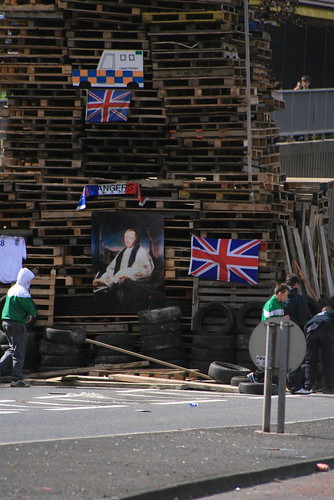Don't worry, the present Bishop of Derry and Raphoe (Ken Good) hadn't been condemned for heresy. Rather, it was a portrait of one of his predecessors, Frederick Augustus Hervey, Bishop of Derry and Earl of Bristol. His portrait sat at the bottom of the bonfire on Lecky Road, near the Brandywell Flyover, and was featured alongside Union Flags, Ulster Flags, Rangers flags and scarf, Irish Football Association flag, and a homemade picture of a PSNI Landrover.

The bonfire has already attracted attention over at Slugger O'Toole, but I want to focus specifically on the Lord Bishop of Derry who was to meet the flames on Assumption Day, 15th August, and ask why they were going to burn him.
Is it because, in copying Loyalist tradition with their parades and bonfires, that they needed someone in episcopal robes in a tit for tat response to the burning of effigies of the Pope on the Eleventh Night (if indeed that still happens)?
Was it because they don't like the Mussenden Temple, which Bishop Hervey erected in the grounds of his palace at Downhill?
Was it to express their hatred of all things Protestant in the city, and his was the only episcopal portrait they could find? If this is the case, then they're terribly wrong in their understanding of Irish history, and particularly of Earl-Bishop Hervey. He was hardly the bastion of Protestant supremacy the Republicans may think him to be.

I haven't got all my history books arranged as I would like them due to small study space on few bookshelves, so my 'History of Ulster' by Jonathan Bardon must be in a box under the spare bed or in a cupboard somewhere. But even a quick Google search on Hervey reveals him to be quite liberal, indeed tolerant of other religious groups in Ireland.
The Encyclopedia Britannica, for example, says this about him:
he was active and philanthropic . While not neglecting his luxurious personal tastes he spent large sums of money on making roads and assisting agriculture, and his munificence was shared by the city of Londonderry . He built splendid residences at Downhill and Ballyscullion, which he adorned with rare works of art . As a bishop, Hervey was industrious and vigilant; he favoured complete religious equality, and was opposed to the system of tithes . In December 1779 he became earl of Bristol, and in spite of his brother's will succeeded to a considerable property . Having again passed some time in Italy, he returned to Ireland and in 1782 threw himself ardently into the Irish volunteer movement, quickly attaining a prominent position among the volunteers, and in great state attending the convention held in Dublin in November 1783 . Carried away by his position and his popularity he talked loudly of rebellion, and his violent language led the government to contemplate his arrest . Subsequently he took no part in politics, spending his later years mainly on the continent of Europe .
The article has been rehashed on Wikipedia, and from it, we can see that the city prospered under Hervey's bishopric, but more importantly, that Hervey was involved in the Volunteers, the forerunners of the United Irishmen, whose vision was to unite Catholic, Protestant and Dissenter together as Irishmen. It was this group which later staged the 1798 Rebellion against the government (which Hervey loudly talk about). So far from Hervey being someone to revile as a British agitator and lord, the (dissident?) republicans in Derry should be finding a friend in Frederick Augustus Hervey.
So why were they burning him? Perhaps we'll never know, unless one of their apologists would like to share their reasons. But one thing is clear - Northern Ireland and Irish history is never simple, and never straightforward!
EDIT: This story made it onto BBC Newsline.
Thanks for this Gary.
ReplyDeleteI remember well the custodian of the National Trust property at the Bishop's Gate - Jan Eccles. Jan devoted the last two decades of her life to developing the gardens and walks and preserving some of the many artifacts.
She told me once that the Earl Bishop had permitted Catholics to gather for worship in the crypt of the Mussenden Tample during penal times. I have not seen this documented anywhere and I don't know her source, but I have no reason to doubt it.
I am in shock !
ReplyDelete